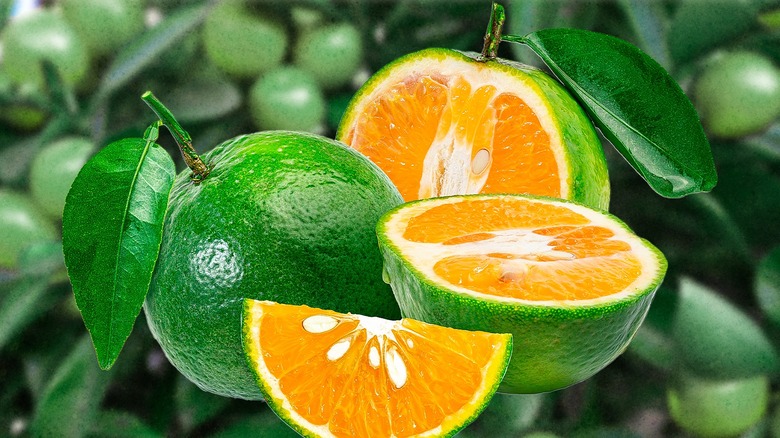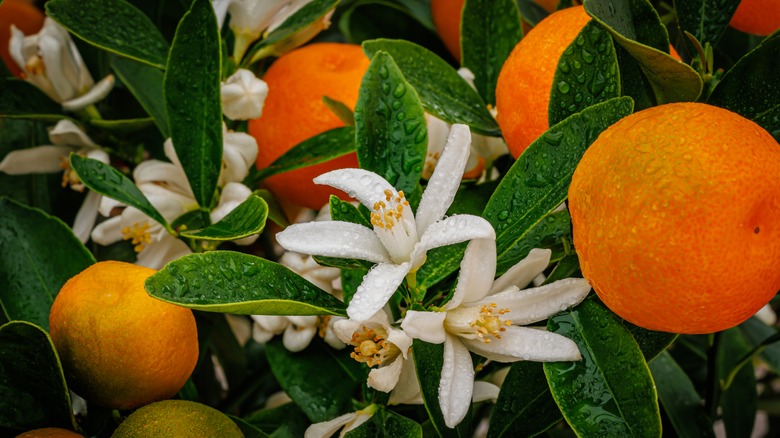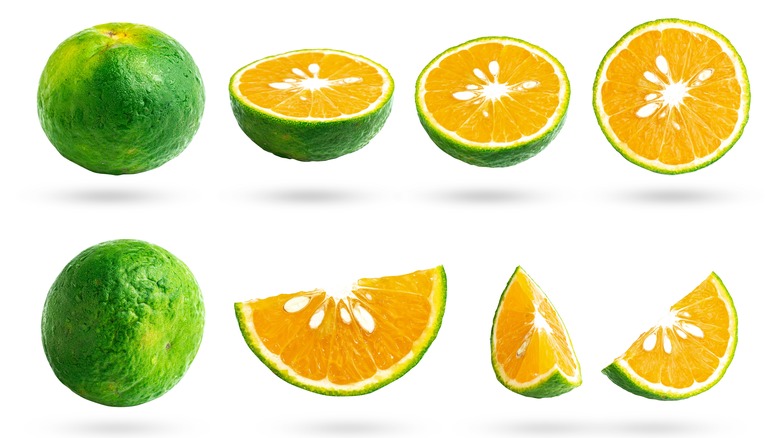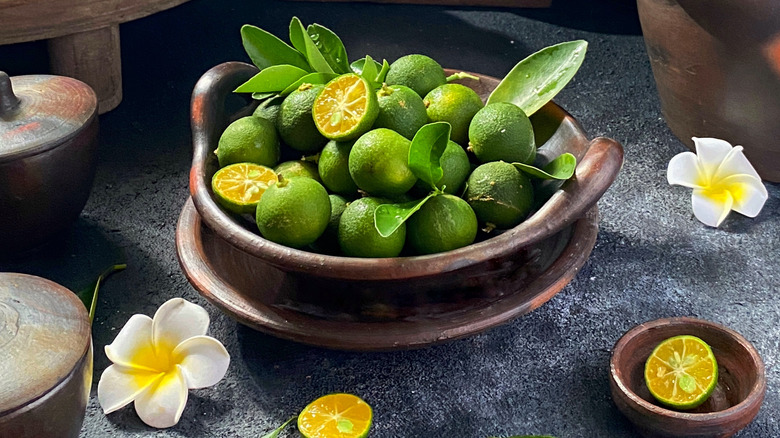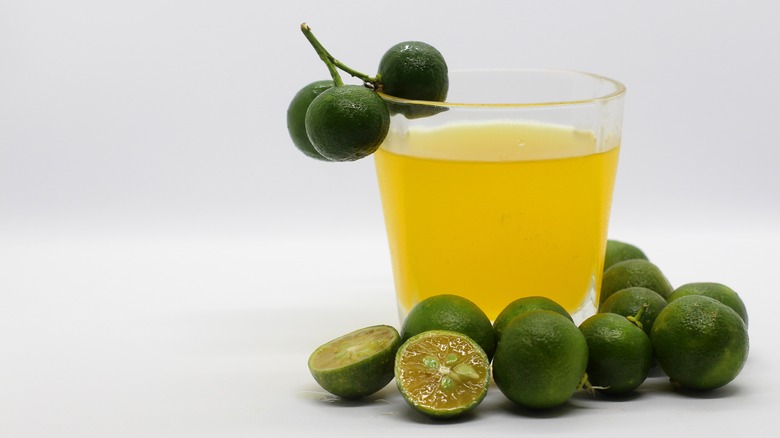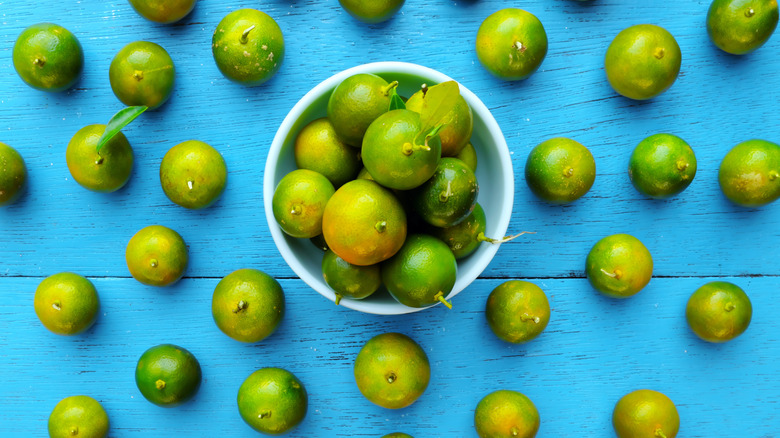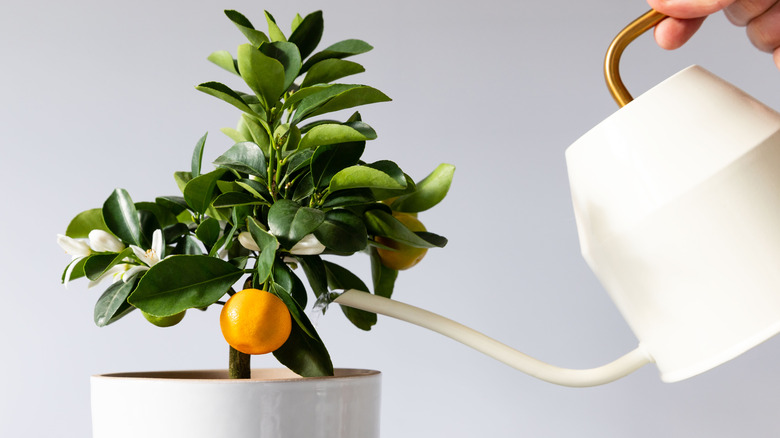What Makes Calamansi Fruit So Unique?
We may receive a commission on purchases made from links.
Have you ever tasted or heard of calamansi fruit? You may already be familiar with this type of lime, or you may know it by another name, like calamondin, Panama orange, calamondin orange, musk lime, golden lime, China orange, limau kesturi, Philippine lime, or acid orange. There are so many designations for what botanists classify as citrus macrocarpa, which is from the Rutaceae or citrus family of flowering plants. Thought to be a hybrid between a mandarin orange and a kumquat, this tangy and versatile fruit is native to the Philippines, where it's used extensively — and not just for cooking. It actually has a long history of treating many ailments, too, like lowering a fever and soothing a sore throat.
But calamansi isn't only cultivated in the Philippines. It also grows abundantly in southern China, Taiwan, Indonesia, Malaysia, and Brunei, among others. You'd think it has only been recently introduced in America, but it made its way there in the early 20th century. Then, it became a staple in cake baking between the 1920s and 1950s, notably in Florida.
Now an important component of Southeast Asian and Central and South American cuisines, calamansi may be small in size, but it is as bold as it is prolific. Here is everything you need to know about this fruit, from its flavor to its health benefits, as well as its many uses.
What calamansi looks and tastes like
Calamansi loves and flourishes in warm temperate, subtropical, and tropical climates best. People in the Philippines, especially those residing in the Oriental Mindoro Province, are known to grow it extensively in their backyard — not just for its many uses, but also for its ornamental value and delicate fragrance.
It's an aromatic tree whose height can range from 10 to 25 feet. Its thin branches not only bear sharp thorns but also dense 1.6- to 2.8-inch-long leaves and white five-petaled flowers that blossom throughout the year. The latter can be used to make honey. These trees bear fruit that is round and small when fertilized, with diameters ranging from 1.2 to 1.6 inches. If the peel is dark green, it means the calamansi is still unripe; if it's bright orange, it's overripe. This is why most people harvest this fruit when it turns green-yellow, though its flesh is always orange with oversized seeds.
It's at this point that the fruit's sour and mildly sweet flavor — described as a cross between lemon, lime, and orange — is most suitable for juices, marmalades, and marinades. And if you think the peel of a calamansi is the tartest part, think again: It's actually the sweetest layer, which tempers the pulp's bright acidity.
What is variegated calamansi?
Just like lemons have a pink variegated variety, this fruit also has a marbled cousin that is worth mentioning. Variegated calamondin or calamansi, known among botanists as citrus macrocarpa variegata or citrus mitis variegata, is a broad-leaved evergreen thought to have originated in China. It was then exported to Indonesia and the Philippines. Not only is the striped foliage green and cream, but so is the peel of the fruit itself, adding to the plant's decorative appeal — especially indoors.
It grows year-round, albeit slower than the regular kind, but particularly in winter. As for its fragrant white flowers, these blossom in late spring and early summer. The fruit has a diameter of about an inch, and even in its fully ripe form, it remains very sour and acidic. Squeeze its juice and use it as a sharper alternative to the classic lemon curd, or add it to soups, stir-fries, pies, cocktails, marmalades, and gelatin.
Variegated calamansi has other uses in Philippine culture, especially in the beauty department. It's common for Filipinos to mix it with hair conditioner, or dab some of the juice on their skin to remove blemishes, freckles, and dark spots, or even treat acne.
What parts of a calamansi fruit are edible?
Along with fish sauce, banana ketchup, shrimp paste, and purple yam, calamansi is a staple in Filipino cuisine. But it's also commonly incorporated into many Chinese, Indonesian, Thai, and Malay dishes. So, the next time you're preparing an Asian-themed feast, make sure, for instance, to add calamansi to your chicken adobo. It's one of many traditional Filipino dishes with Hispanic influence. It doesn't matter if you add the pulp, juice, peel, or rind to your dish, as long as that bright flavor is there to enhance it.
Similarly to kumquats, the entire fruit is edible, from the lightly sweet and thin exterior to the acidic and juicy orange flesh. You can enjoy a calamansi whole with a cocktail or some whiskey; or mix it with your fruit salad for a sharper, more intense tang. The juice can also be used to make syrups or add zing to a regular lemonade. Not to mention that candied calamansi peels are also very popular delicacies, and they pair well with dark chocolate.
How to use this citrus fruit in the kitchen
Now that this fruit's characteristics and versatility have been established, let's dive further into some of its many culinary uses. Good thing it can be incorporated into both sweet and savory dishes, sauces, and beverages.
For example, there are various types of soy sauce, from sweet to tamari and mushroom infused. As for the traditional Filipino take, this sauce is called toyomansi, a combination of the words toyo (meaning "soy sauce" in Tagalog) and mansi, which is a contraction of — you've guessed it — calamansi. People can either buy bottled toyomansi at the store or concoct their own marinade or dip base at home, bearing in mind that the juice has to be freshly squeezed for optimum results and a more tender meat. This popular marinade is also used with crispy chicken (not unlike the Chinese American orange chicken), seafood dishes, beef, and pork chops.
For those who'd prefer a lighter option, calamansi would also pair well with a refreshing and flavorful chicken mango salad, as a substitute for lime juice. Additionally, some high-end brands sell concentrated calamansi vinegar, and only a few drops are enough to elevate your poached fish, rice, or chicken. The possibilities are truly endless, from a limoncello-inspired dessert drink to calamansi, papaya, and coconut popsicles, as well as complementing your hot or cold tea and coffee beverages.
Health information about calamansi
Calamansi doesn't only elevate your dishes, sauces, marinades, dips, desserts, and drinks, but it is also said to carry numerous health benefits, just like many other citrus fruits. For example, the high concentration of vitamin C is supposed to improve your immune system and combat fatigue, while the pectin in the calamansi could very well help lower your cholesterol. Not to mention that this fruit also has antibacterial properties, could possibly stabilize your glucose level, and even help you lose weight.
The National Library of Medicine's review of a 2023 article called "Phytochemicals, Bioactive Properties, and Commercial Potential of Calamondin (Citrofortunella microcarpa) Fruits" sheds further light on the citrus fruit's potential health benefits. It praises calamansi's anti-cancer properties, suggests that its juice helps combat phlegm and coughs when combined with salt, and indicates that both the peel and pulp boast high amounts of dietary fiber. The fruit's citric acid, calcium, and potassium might help stabilize blood pressure and lower the risk of kidney stones, and its rind could play an active role against acid reflux disease.
That said, per Lybrate's 's Dr. A.A. Khan, calamansi may also leave you with a few unwelcome side effects if not consumed in moderation, such as diarrhea and cramping. It may even worsen your acid reflux, instead of alleviating it.
Other uses of this unique citrus fruit
Calamansi is a bold ingredient in the kitchen, a fragrant home decoration, and it can potentially help heal many sicknesses. But this unique fruit has also been traditionally used in wellness, cosmetics, and commercial skin products for many years.
As a natural exfoliant, it may help boost and rejuvenate your skin and even out your complexion, not to mention reduce inflammation and prevent excess oil. It is used in some creams, serums, soaps, cleaners, and toners to fight hyperpigmentation, give the face a natural glow, and reduce acne scars. As for the ever-popular Korean sheet masks, some of them contain calamansi as a revitalizing, brightening, and moisturizing agent. But that's not all this tiny fruit has to offer in term of external use. As an essential oil, it is a potent agent in aromatherapy sessions and soothing massages.
Moreover, if mixed with distilled vinegar, either as an oil or in fresh peels, it becomes a natural, safe, all-purpose cleaning and disinfecting product, thought to be potent enough to remove mold and stubborn stains and smells. As a household item, it can therefore be useful in laundry, on furniture, and just about any surface (just be careful with surfaces like granite, marble, and some metals due to its potentially corrosive nature, however). What a prolific fruit!
Calamansi vs. yuzu
The citrus family boasts a wide array of shapes, colors, sizes, flavors, and textures. Some people might compare calamansi to yuzu, a key component of Japanese cuisine. Indeed, both fruits are intensely fragrant, turn yellow-green when ripe, contain abundant seeds, are boldly acidic with a hint of sweetness, and are used as alternatives to lemons and oranges in the kitchen. Yuzu, though, offers a distinctive mix of grapefruit, mandarin, and lemon. Additionally, its peel is thick and bumpy, unlike calamansi's smooth and thin surface. However, both of them are commonly used in vinaigrettes, marinades, marmalades, sauces, tea, desserts, and drinks.
On to yuzu's purported health benefits. It's apparently a great source of vitamins C and A, and it may help to keep inflammation, blood sugar, cholesterol, heart disease, and cancer in check. Additionally, yuzu could lighten and tighten the skin, and it is also used in aromatherapy and massages to reduce stress and relieve tension. And as far as house chores are concerned, it can also be used as a safe cleaning agent and may even reduce wrinkles on fabrics.
Where to buy fresh calamansi and related products
Calamansi grows throughout the year, but it's in peak season between the middle of August to October — at least in the Philippines. Freshly harvested, it can be found anywhere in Southeast Asia and Central America, but it may be a little harder to come by in the U.S., at least compared to limes and lemons. Your best bet is to check your local Asian or Hispanic store. Phil-Am Market in Moreno Valley, California, for one, currently sells it fresh starting at $1.35.
Just make sure to pick the calamansi that are just starting to change from pale green to yellow and have very smooth and firm skin. You can then store them at room temperature for about a week or keep them refrigerated in a dry container for up to two. Alternatively, the practical long-term solution would be to extract the juice and pour it in an ice-cube tray to use later on. You might also prefer to buy a potted tree online and nurture it at home; the cost can range from around $55 on Amazon to $119 on Yarden's website, as of this writing.
We also recommend trying some of the numerous calamansi-related products — also available online and at select markets. Amazon, for instance, currently sells pouches of real calamansi extract for $14.95, a 5-pack of calamansi-flavored sparkling water $12.65, and three bottles of Maggi calamansi liquid seasoning for $16.99. Meanwhile, tangy calamansi marmalade can be ordered through Pika Pika for $16.
How to care for your own calamansi shrub
Convinced of calamansi's culinary, medical, wellness, cosmetic, cleaning, and ornamental value yet? Then you might be interested in growing and nurturing your own shrub — if you live in an area with hot summers and mild winters, that is. It's much easier and more practical to buy the plant directly instead of starting from the seeds.
Experts over at Epic Gardening and Forestry.com give ample tips for a healthy, long-lasting plant. Begin by ordering it in spring or summer, as cold temperatures may be detrimental while the plant is transported to your home. Once rehomed, the calamansi can be planted directly in your garden, as long as the soil is coarse and remains moist (but not drenched). Alternatively, you may prefer to keep the plant in a pot inside your house, preferably in your sunniest room. It will need at least six hours of direct sunlight per day and should be watered once per week. Therefore, make sure your pot is well-draining and lightweight enough to move around, and only use citrus-specific fertilizers. As for pruning, it is recommended in late winter and early spring.
